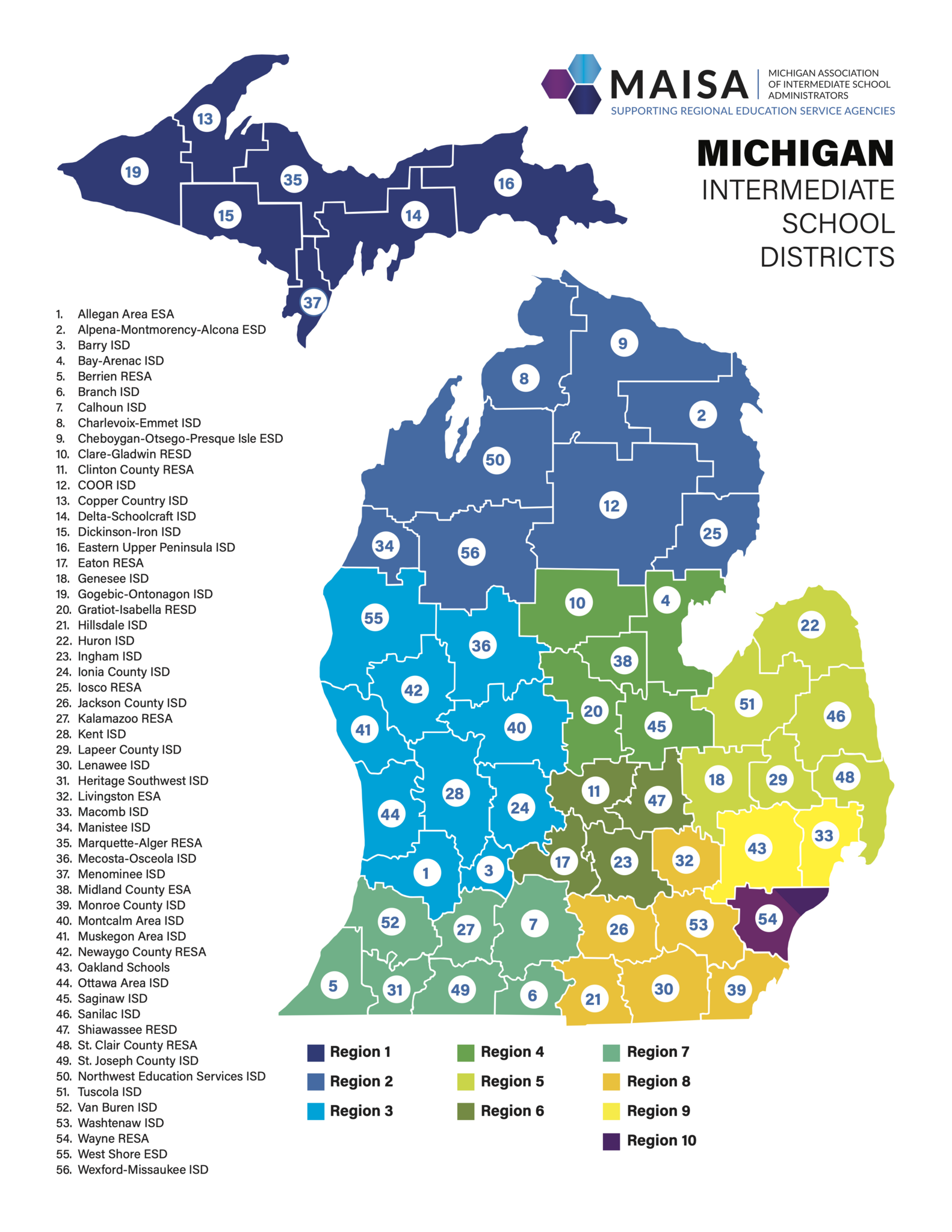Intermediate School Districts
What is an ISD
Michigan-Made Intermediate School Districts add value to students, schools, and communities by providing student-centered, data-driven, expanded educational opportunities. ISDs — which sometimes go by the name Regional Educational Service Agency (RESA) or Educational Service Agency (ESA) — work with local school districts, the Michigan Department of Education, business and industry, and community groups. They support student achievement and leverage limited resources in the following areas.
Teaching and Learning
ISDs offer literally thousands of professional learning sessions each year to educators, keeping them up on the latest research and teaching methods.
For example: one ISD supports 16 local districts across five counties with instructional best practices and student learning through strategic work with a regional implementation of the Marzano Teacher Evaluation Model. This ISD lends support to ISDs across the State of Michigan in any of the state-appointed teacher evaluation models through on-site coaching support.
Specialized Student Services
Local school districts depend on ISDs to meet ever-growing needs in Early Childhood (0-5) and Parent Education, Special Education (birth to age 26), Career and Technical Education, Tech Prep, Career Preparation, Talent Development, Online and Digital courses, Math and Science programs, Early/Middle College, Student Activities, Extended Day, Alternative and Adult Education programs, and Court-Involved Youth and Homeless Education programs.
For example: one ISD has been securing meaningful employment for students with disabilities. In a Project SEARCH environment, an employer provides internships for students to experience a work environment and find a good fit for the future. Through the Project SEARCH program, the ISD has secured employment for every participating student after graduation.
For example: another ISD provides prevention services for a tri-county area offering programs and trainings such as signs of suicide, teen parent case management, pregnancy prevention and peer assistance leaders with over 29 participating school buildings.
Shared Operational Services
Quality, efficiency, and cost containment are the hallmark of ISDs as they help districts share services in technology, instruction, transportation, business, communication and support services, teacher and school staff training, and purchasing.
For example, one ISD, which processes the billing for 28 local public school districts and two public school academies for Medicaid-eligible students receiving special education services, saved schools $7,913,061 through Medicaid revenue.
For example: another ISD reduced ISD-wide special education transportation contract costs by $1.7 million dollars per year over the last 10 years, for a total of $17 million to date. This was achieved by developing a vendor contract that incorporates industry best practices based on input from a national expert. Ongoing contract monitoring assures safe and efficient daily transportation for 900 students with special needs to over 100 program sites throughout the service area.
Developing Partnerships
ISDs are often key partners in local economic development through their community ties with colleges and universities, businesses, industries, and human service agencies. Many of these partnerships benefit our schools and students by readying them for 21st Century careers.
For example: a regional collaboration between area employers, civic and community organizations, and one ISD and its member schools, incorporates teacher training in Project-based Learning, Design Thinking and innovative partnerships. This allows students to gain real-world experiences and employability skills for success in the 21st century workforce while working on site at employer facilities.
Technology Services
Four ISDs have merged their technology services to form a cooperative known as the Education Technology Association. This association provides comprehensive staffing support, ranging from computer technicians to network engineers, for schools. Additionally, they have streamlined essential systems such as firewalls, networks, servers, and phone systems, leading to significant annual savings for the districts.
School Improvement, Assessment and Mandates
ISDs help member districts follow often-complex state and federal education standards, meet state and federal requirements, secure grants, measure student performance and growth, and assist low performing schools.
For example, one ISD, using dollars awarded by the Michigan Department of Education for priority schools, worked with all the priority schools in its largest urban setting to improve student outcomes. By the second year, all of those school buildings were removed from the priority list.
In addition, each ISD customizes services to meet unique needs. Each ISD works with its local school districts to develop the mix of products and programs to maximize benefits for that area. These are only a few examples of how today’s ISDs serve urban, suburban and rural K–12 districts, enabling even the most challenged school to offer otherwise unavailable educational opportunities to its students. And, ISDs are being asked to do more for students, schools and communities every day. To learn more about the integral role of ISDs in education, contact the Michigan Association of Intermediate School Administrators.
Value of ISDs
Now, more than ever before, Michigan's intermediate school districts are ensuring high-quality, effective, efficient, equitable, and essential education everywhere in Michigan.
From the day the Legislature created them in 1962, Michigan's ISDs continue to:
- Maximize resources for K–12 districts by providing shared operational services.
- Train teachers and support staff in the latest research-based methods and best practices.
- Pilot innovative programs that districts couldn't afford on their own.
- Coordinate special education and other specialized student services across their region.
ISDs are the only educational entities with 100% access to every public school to ensure the implementation of six core services.
Michigan Intermediate School Districts
2. Alpena-Montmorency-Alcona ESD
3. Barry ISD
5. Berrien RESA
6. Branch ISD
7. Calhoun ISD
9. Cheboygan-Otsego-Presque Isle ESD
12. COOR ISD
16. Eastern Upper Peninsula ISD
17. Eaton RESA
18. Genesee ISD
21. Heritage Southwest ISD (formerly LCISD)
22. Hillsdale ISD
23. Huron ISD
24. Ingham ISD
25. Ionia County ISD
26. Iosco RESA
28. Kalamazoo RESA
29. Kent ISD
31. Lenawee ISD
32. Livingston ESA
33. Macomb ISD
34. Manistee ISD
37. Menominee ISD
42. Northwest Educational Services (formerly TBAISD)
44. Oakland Schools
45. Ottawa Area ISD
46. Saginaw ISD
47. Sanilac ISD
48. Shiawassee RESD
51. Tuscola ISD
52. Van Buren ISD
53. Washtenaw ISD
54. Wayne RESA
55. West Shore ESD

